
Nakskov is a market town on the island of Lolland in south Denmark. The town has a population of 12,445 and is the largest town on the island of Lolland. It is located in Lolland municipality in Region Sjælland.

Maribo Cathedral is a Lutheran cathedral church built in the Gothic style in Maribo on the island of Lolland in the southeast of Denmark. It was originally part of Maribo Abbey which was founded in the early 15th century. The chancel, the oldest section of the cathedral, probably dates from 1416. The plan of the church is unusual in that the chancel is at the west end of the building rather than the east as a result of the design instructions left by Saint Bridget.
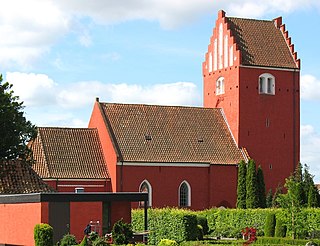
Nørre Alslev Church in the small town of Nørre Alslev in the north of Danish island of Falster dates from at least 1308, a date found on its early frescos. Built in the Early Gothic style and painted pink according to local tradition, it is best known for its fresco of the death dance.

Torkilstrup Church is located in the village of Torkilstrup some 7 km (4 mi) southeast of Nørre Alslev, on the Danish island of Falster. It is built of hewn fieldstone rather than brick, indicating it is one of the oldest churches on the island from before 1160.
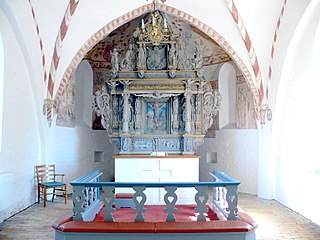
Jørgen Ringnis, also known as "Jørgen Billedsnider", was a Danish woodcarver. He created a number of altarpieces and pulpits in Danish churches, especially on the islands of Lolland and Falster.

Eskilstrup Church is a church in Eskilstrup, Denmark. The church dates from the 12th century and was built in the Romanesque style. In accordance with a local tradition, it is painted red. It is best known for its frescos, said to be Denmark's oldest.
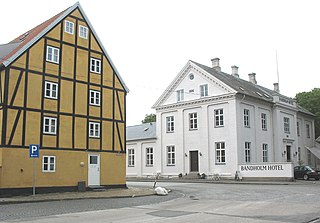
Bandholm is a small port town and parish on the coast of northern Lolland, Region Zealand, Denmark. On 1 January 2024 it had a population of 443, and is located to the northwest of Knuthenborg Safari Park and Maribo. From Bandholm there is ferry service to Askø and rail link to Maribo, 8 km (5.0 mi) north of Maribo. Stokkemarke is its west and Østofte Parish forms its southwest border. It is served by Bandholm Station. The Maribo-to-Bandholm rail branch is operated by the Museumsbanen Maribo-Bandholm as a preserved railway.

Toreby Church is the parish church of Toreby on the Danish island of Lolland. It is an unusually large red-brick Romanesque building, the nave and chancel having been extended in the Gothic period with a sacristy and lateral aisle. The tower is late Romanesque. There are frescos from c. 1400 in the sacristy. The carved pulpit (1645) is the work of Jørgen Ringnis.

Østofte Church, located in the village of Nørreballe on the Danish island of Lolland, was built in the 14th century. The Romanesque apse, chancel and nave formed the original building while the tower and porch were added in the Late-Gothic period and the north wing was completed in 1656.
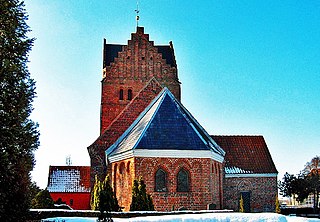
Stokkemarke Church is located in the village of Stokkemarke some 11 km (6.8 mi) northwest of Maribo on the Danish island of Lolland. Dating from the middle of the 13th century it was built in the Romanesque style with later additions in the Gothic period.
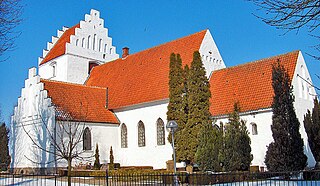
Hunseby Church is located in the village of Hunseby some 3 km north of Maribo on the Danish island of Lolland. Built in the middle of the 12th century, the church has a Romanesque chancel and nave and a Gothic tower.

Hunseby is a village located some 3 km (1.9 mi) north of Maribo on the Danish island of Lolland. It belongs to Lolland Municipality in Region Sjælland. As of 2024, it has a population of 399.

Sandby Church is located in the village of Sandby some 7 km northwest of Nakskov on the Danish island of Lolland. Dating from the middle of the 13th century, the church has a Romanesque chancel and nave and a Late Gothic tower.

Sandby is a village located some 7 km (4.3 mi) northwest of Nakskov on the Danish island of Lolland. It belongs to Lolland Municipality in Region Sjælland. As of 2024, it has a population of 348.

Nakskov Church is the largest church in Nakskov on the west coast of the Danish island of Lolland. As Nakskov was mentioned in Valdemar's Census Book in the 13th century, the church probably dates to the same period.

Birket Church is located south of the little village of Birket, some 14 km (8.7 mi) northeast of Nakskov on the Danish island of Lolland. Its chancel was originally the nave of the brick Gothic church built in 1350. The bell tower, which stands apart from the church, is believed to be Denmark's oldest standing wooden structure.

Avnede Church is a Gothic church located some 7 km (4.3 mi) southeast of Nakskov on the Danish island of Lolland. Frescos discovered on the chancel arch during repairs in 2009 are now being restored by the National Museum.

Dannemare Church is a Neo-Romanesque church in the village of Dannemare, some 12 km (7.5 mi) south of Nakskov on the Danish island of Lolland. Built in 1897, it replaced the earlier Romanesque church which burnt down in 1897.
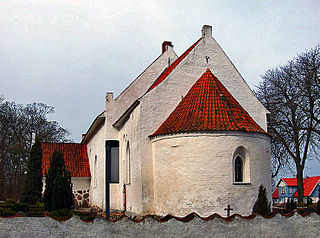
Arninge Church is a Late Romanesque church in the little village of Arninge, some 8 km (5.0 mi) south of Nakskov on the Danish island of Lolland. Built of red brick in the 13th century, it has an intricately carved auricular altarpiece created by Henrik Werner in 1644.

Gloslunde Church is a Romanesque church east of Dannemare, some 13 km (8.1 mi) southeast of Nakskov on the Danish island of Lolland. Now whitewashed, it was built of red brick in the 13th century. The heritage listed Gloslunde Rectory is located next to the church.



















